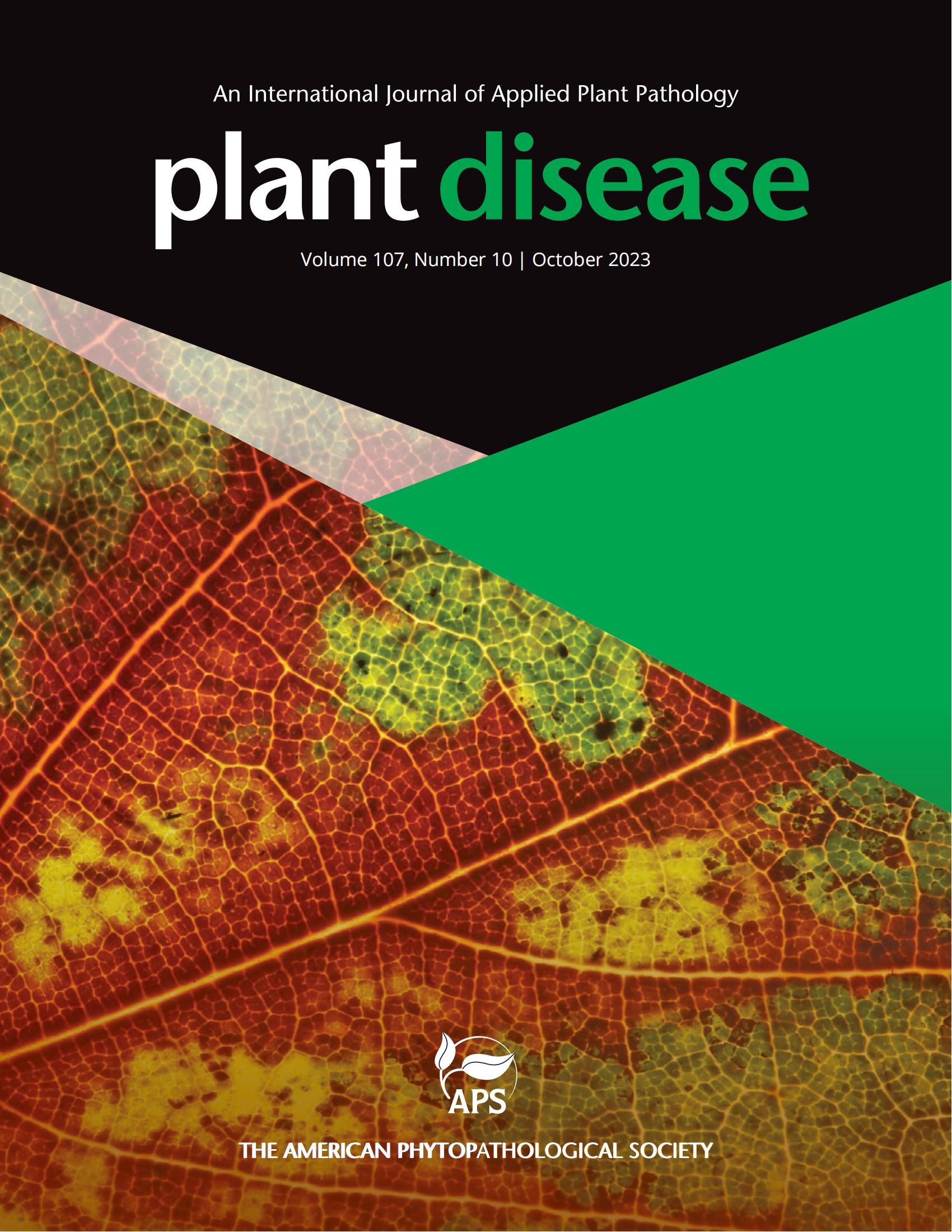中国芒果细菌性枯死病防中代首次报道。
摘要
芒果(Mangifera indica L.)是一种全球重要的热带水果,是中国海南省的主要经济作物。2024年9月,两个芒果人工林(人工林1:18.440450°N, 109.112387°E;海南三亚市台风季强降雨后,种植面积2:18.327334°N, 109.418158°E)。1号人工林(7公顷)的发病率约为20%,2号人工林(13.5公顷)的发病率约为50%。最初症状包括叶基脉间积水,沿叶脉扩展成黑色坏死条纹,向叶柄和茎部发展。严重感染导致部分或全部枝条枯死,并伴有茎、芽和叶柄上坏死病变的白色乳白色渗出物。每个人工林采集1片叶片、1个果实和1个茎,共6份样品进行病原菌分离。病变组织片段(5 × 5mm)在70%乙醇中表面消毒1分钟,切碎,悬浮在灭菌水中。将得到的悬浮液涂布在Luria-Bertani (LB)琼脂板上,28°C孵育2天。在所有6个样本中,主要观察到边缘不规则的小黄白色细菌菌落。三个代表性的分离株(来自人工林1的MG2-2,来自人工林2的MG3-1和MG2-2)进行了进一步的鉴定。分离的细菌呈棒状,革兰氏阴性,可运动,兼性厌氧生长,利用D-葡萄糖,蔗糖,D-(+)-半乳糖,但不利用D-山梨醇和麦芽糖(Li,et al, 2024)。提取细菌细胞的总DNA,使用引物27f和1492r扩增16S rRNA序列(GenBank: PQ967981-PQ967983) (Heuer et al., 1997)。16S rRNA序列与Dickeya fangzhongdai菌株B16 (CP087226)的同源性为100%,与D. fangzhongdai菌株JS5 (NR_151914)的同源性为99.78%。扩增到fusA、dnaX、gapA、gyrA、purA、recA、rplB、rpoB、rpoD、rpoS (PQ900325 ~ PQ900354)基因。基于16S rRNA序列和10个基因序列的最大似然系统发育分析将3个具有代表性的分离株置于一个支系中,该支系包括方中代Dickeya fangzhongdai。用菌株MG2-2 (OD600 = 1.0)菌悬液接种6株4年生芒果(品种:金黄)幼苗,证实其致病性。用一次性无菌注射器将10 μL菌悬液注射到茎中,并将5 mL菌悬液喷洒在叶片上。对照植株接种LB培养基。接种7天后,接种的芒果幼苗茎部出现白色乳白色的坏死灶,叶片出现部分枯死症状,而对照则无症状。从有症状的茎和叶中重新分离出该细菌,其培养、生理、生化特性与MG2-2相同。在中国,早有报道称D. fangzhongdai是梨出血溃疡病、芋头软腐病、香蕉花梗软腐病的致病因子(Huang et al., 2021;Yang et al., 2022)。据我们所知,这是国内第一次报道防中代致病菌引起芒果枯死。Mango (Mangifera indica L.), a globally significant tropical fruit, is a major economic crop in Hainan Province, China. In September 2024, serious dieback symptoms were observed in two mango plantations (plantation 1: 18.440450 °N, 109.112387 °E; plantation 2: 18.327334 °N, 109.418158 °E) following heavy rainfall during the typhoon season in Sanya City, Hainan Province. Disease incidence reached approximately 20% in plantation 1 (7 ha) and 50% in plantation 2 (13.5 ha). Initial symptoms included water-soaked interveinal lesions at leaf bases, which expanded into black necrotic streaks along veins, progressing to petioles and stems. Severe infections resulted in partial or complete branch dieback, accompanied by white milky exudates from necrotic lesions on stems, buds, and petioles. For pathogen isolation, one leaf, one fruit and one stem sample were collected from each plantation, totaling six samples. Diseased tissue segments (5 × 5 mm) were surface-sterilized in 70% ethanol for 1 minute, minced, and suspended in sterilized water. The resulting suspensions were streaked onto Luria-Bertani (LB) agar plates and incubated at 28 °C for 2 days. Small yellow-white bacterial colonies with irregular margins were predominantly observed across all six samples. Three representative isolates (MG2-2 from plantation 1, MG3-1 and MG3-2 from plantation 2) were subjected to further characterization. The isolated bacteria were rod-shaped, gram-negative, motile, facultatively anaerobic growth, and utilized D-glucose, sucrose, D-(+)-galactose, but not D-sorbitol and maltose (Li,et al., 2024). The total DNA of these bacterial cells was extracted and used to amplify the sequences of 16S rRNA (GenBank: PQ967981-PQ967983) using primers 27f and 1492r (Heuer et al., 1997). The 16S rRNA sequences exhibited 100% identity with Dickeya fangzhongdai strain B16 (CP087226) and 99.78% identity with the D. fangzhongdai strain JS5 (NR_151914). Additionally, the fusA, dnaX, gapA, gyrA, purA, recA, rplB, rpoB, rpoD, rpoS (PQ900325 to PQ900354) genes were amplified. A maximum-likelihood phylogenetic analysis based on the concatenated sequences of the 16S rRNA and the ten genes placed the three representative isolates within a clade comprising Dickeya fangzhongdai. Pathogenicity was confirmed by inoculating six 4-year-old mango seedling (cultivar: Jinhuang) with a bacterial suspension of strain MG2-2 (OD600 = 1.0). A 10 μL bacterial suspension was injected into the stems using a sterile disposable syringe, and 5 mL of the bacterial suspension was sprayed onto the leaves. Control plants inoculated with LB medium. Seven days post-inoculation, necrotic lesions with white milky gum were observed on the stems of the inoculated mango seedlings, and partial dieback symptoms appeared on the leaves, while controls remained asymptomatic. The bacterium was reisolated from the symptomatic stems and leaves, and the isolates exhibited the same cultural, physiological, biochemical characteristics as MG2-2. D. fangzhongdai has previously been reported as the causal agent of pear bleeding canker, taro soft rot, banana peduncle soft rot in China (Huang et al., 2021; Yang et al., 2022). To our knowledge, this is the first report of D. fangzhongdai causing dieback on mango in China.

 求助内容:
求助内容: 应助结果提醒方式:
应助结果提醒方式:


